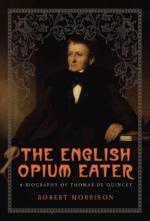|
This section contains 6,114 words (approx. 21 pages at 300 words per page) |

|
SOURCE: “The ‘Dark Problem’ of Greek Tragedy: Sublimated Violence in De Quincey,” in The Wordsworth Circle, Vol. 29, No. 2, Spring, 1998, pp. 114-20.
In the following essay, Rzepka contends that De Quincey's portraits of violence are deeply influenced by his reading of Greek and Shakespearean tragedy.
“The Greek Tragedy is a dark problem,” announces Thomas De Quincey at the beginning of his essay, “Theory of Greek Tragedy” (X, 342),1 the problem being, first, how to distinguish between Greek and Modern, or “Shakespearean,” tragedy, and secondly, how to make this distinction intelligible to the un-Greeked, middle-class audience of Blackwood's Edinburgh Magazine in February, 1840. De Quincey, an adept popularizer, solves both problems by nesting Greek Tragedy within the framework of a Shakespearean example universally familiar to the literate classes of England: the “play within a play” of Hamlet, which he likens, in turn, to a painting within a painting:
We see a chamber...
|
This section contains 6,114 words (approx. 21 pages at 300 words per page) |

|


